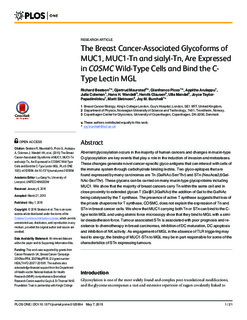| dc.contributor.author | Beatson, Richard | |
| dc.contributor.author | Maurstad, Gjertrud | |
| dc.contributor.author | Picco, Gianfranco | |
| dc.contributor.author | Arulappu, Appitha | |
| dc.contributor.author | Coleman, Julia | |
| dc.contributor.author | Wandell, Hans H | |
| dc.contributor.author | Clausen, Henrik | |
| dc.contributor.author | Mandel, Ulla | |
| dc.contributor.author | Taylor-Papadimitriou, Joyce | |
| dc.contributor.author | Sletmoen, Marit | |
| dc.contributor.author | Burchell, Joy | |
| dc.date.accessioned | 2015-11-25T11:17:12Z | |
| dc.date.accessioned | 2016-01-05T15:12:12Z | |
| dc.date.available | 2015-11-25T11:17:12Z | |
| dc.date.available | 2016-01-05T15:12:12Z | |
| dc.date.issued | 2015 | |
| dc.identifier.citation | PLoS ONE 2015, 10(5) | nb_NO |
| dc.identifier.issn | 1932-6203 | |
| dc.identifier.uri | http://hdl.handle.net/11250/2372676 | |
| dc.description.abstract | Aberrant glycosylation occurs in the majority of human cancers and changes in mucin-type O-glycosylation are key events that play a role in the induction of invasion and metastases. These changes generate novel cancer-specific glyco-antigens that can interact with cells of the immune system through carbohydrate binding lectins. Two glyco-epitopes that are found expressed by many carcinomas are Tn (GalNAc-Ser/Thr) and STn (NeuAcα2,6GalNAc-Ser/Thr). These glycans can be carried on many mucin-type glycoproteins including MUC1. We show that the majority of breast cancers carry Tn within the same cell and in close proximity to extended glycan T (Galβ1,3GalNAc) the addition of Gal to the GalNAc being catalysed by the T synthase. The presence of active T synthase suggests that loss of the private chaperone for T synthase, COSMC, does not explain the expression of Tn and STn in breast cancer cells. We show that MUC1 carrying both Tn or STn can bind to the C-type lectin MGL and using atomic force microscopy show that they bind to MGL with a similar deadadhesion force. Tumour associated STn is associated with poor prognosis and resistance to chemotherapy in breast carcinomas, inhibition of DC maturation, DC apoptosis and inhibition of NK activity. As engagement of MGL in the absence of TLR triggering may lead to anergy, the binding of MUC1-STn to MGL may be in part responsible for some of the characteristics of STn expressing tumours. | nb_NO |
| dc.language.iso | eng | nb_NO |
| dc.publisher | Public Library of Science | nb_NO |
| dc.title | The breast cancer-associated glycoforms of MUC1, MUC1-Tn and sialyl-Tn, are expressed in COSMC wild-type cells and bind the C-type lectin MGL | nb_NO |
| dc.type | Journal article | nb_NO |
| dc.date.updated | 2015-11-25T11:17:12Z | |
| dc.source.volume | 10 | nb_NO |
| dc.source.journal | PLoS ONE | nb_NO |
| dc.source.issue | 5 | nb_NO |
| dc.identifier.doi | 10.1371/journal.pone.0125994 | |
| dc.identifier.cristin | 1252284 | |
| dc.description.localcode | © 2015 Beatson et al. This is an open access article distributed under the terms of the Creative Commons Attribution License, which permits unrestricted use, distribution, and reproduction in any medium, provided the original author and source are credited. | nb_NO |
